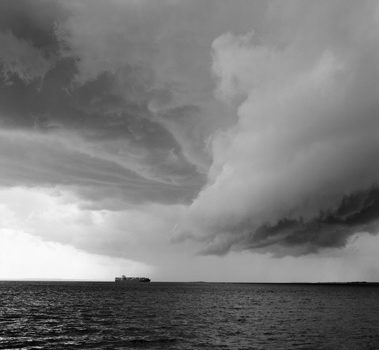Mitch Epstein is one of the most prominent American photographers of his generation. Five years after his exhibition American Power at the Fondation Cartier-Bresson, he is returning to Paris, to the gallery Les Filles du Calvaire, with a potent trilogy to be exhibited in France for the first time: New York Trees, Rocks & Clouds.
How humans relate to their environment, to other people, and to modernity is a thread that runs through the grand narrative Mitch Epstein has been elaborating for over forty years, as much in the United States as in Europe, India, and Vietnam. Begun in the 1970s with observations of American culture and American landscapes, devoid of critical judgment and didacticism, the series Recreation looked at what Americans did in their free time. The work that followed, always in color, revolved around recurrent themes: The City (1995–98) and the relationship between public and private space; Family Business (2000–02) took a more nuanced perspective on the American dream as documented through the demise of his father’s business. Later on, in the vast project American Power (2003–08),for which he won the Prix Pictet, Mitch Epstein started work on measuring the impact of energy production on ways of life and its imprint on the landscape.
Unusual among his American contemporaries, Epstein developed a political critique by questioning the symbolism of what it means to be American and by observing the impact of the economy on society and the environment. His experiences abroad provided him with opportunities to export the issues encountered in the West. In India, where he lived in the 1980s and made films with his first, Indian, wife (Salaam Bombay!; Mississippi Masala), he composed images free of any exoticism, inspired by his private life and everyday experiences. In the series Vietnam (1993–95), compiled in a superb monograph (Vietnam: A Book of Changes, W.W. Norton & Company, 1996), the artist offers us a heartbreaking look at the consequences of imposed modernity. This theme, like in a musical score, lends his work remarkable consistency.
The latest three collections, showcased at the gallery, are a continuation of Epstein’s research, directing it toward an inventory of natural motifs—the result of long-term labor of classification. Once inventoried, trees, rocks, and clouds resonate with an original conception of landscape: this is not about formally isolated objects, but about a tangible testimony to the relationship between humans and nature. When he captures a turbulent sky above architecture of glass and concrete, or a contorted branch growing in the city, Mitch Epstein explores above all the extent of the human conquest of nature and our attempts at cohabitation.
In a 1973 essay entitled Frederick Law Olmsted and the Dialectical Landscape, written more than a century after Central Park had been designed by the landscape artist Frederick Law Olmsted, the American artist Robert Smithson foregrounded the confrontation between the natural and the urban environments, which he viewed in terms of earth sculpture. He asked that we “imagine [ourselves] in Central Park one million years ago,” and remarked how “the notion of the park as a static entity is questioned by the camera’s eye.” To Smithson, Central Park is “a ground work of necessity and chance”; and Mitch Epstein is keenly aware of the energy generated in the encounter.
Although Epstein focuses on these contradictions, his photographs transcend a simple opposition between nature and culture by allowing the shock of the sublime to either intervene or not. In addition to Central Park, the whole city of New York and its boroughs become the terrain of a cartographic project punctuated by clouds, trees, and rocks. The effectiveness of black and white film—which is new in Epstein’s work—along with its infinite range of greys, underscore the intrinsic formal vigor of these three motifs: swaths of clouds, audacious crowns of trees, and anarchic layers of rock.
By partially attenuating the colors of the city, Mitch Epstein zooms in on its essence. By choosing the sky, rocks, and trees, he incorporates picturesque effects in his documentary pursuits, bringing traditional elements into play. His aesthetic model, supported by this treatment, is based on a contemplative approach to time, which combines different temporalities in a single image. The series New York Arbor, made between 2011 and 2012, is a collection of portraits of trees populating the city. These silent sentinels, sometimes over a century old and yet often neglected, are undoubtedly privileged witnesses to urban expansion and the succession of human generations animating it. Here, the geologic scale, patient and infinite, evokes the dawn of human life on earth.
The artist’s latest series, Rocks and Clouds (2014–15) continues his New York studies by mapping rocks and identifying their manifest sculptural qualities. These are the very qualities that Olmsted exploited one hundred and fifty years ago by using stones as a record of an unfathomable past. Coming in contact with those historical traces, dislocated and staged from the days of Native Americans, Epstein reveals how humans fashion and manipulate the landscape. In the unpredictability and instability of clouds, Epstein recognizes the potential for expanding one’s contemplative horizons onto observation closely tied to experience and anchored in the present. By pointing his camera at the changing sky and contrasting the latter with the hieratic modernism of architecture, he focuses his study on the moment. Like a researcher, Mitch Epstein extracts indexical material from the silence of the sky and organic bodies. His trilogy constitutes an exceptional documentary study, not only of New York landscapes but also of the history driven by human desires to appropriate nature.
Sébastien Borderie
Sébastien Borderie is a writer specializing in photography. He lives and works in Paris.
Mitch Epstein, New York Trees, Rocks & Clouds
March 17 to May 6, 2017
As part of Mois de la Photo du Grand Paris 2017
17, rue des Filles-du-Calvaire
75003 Paris
France
















